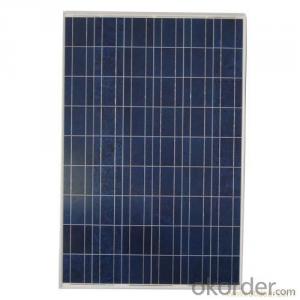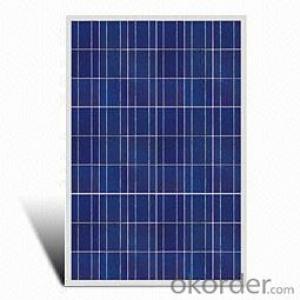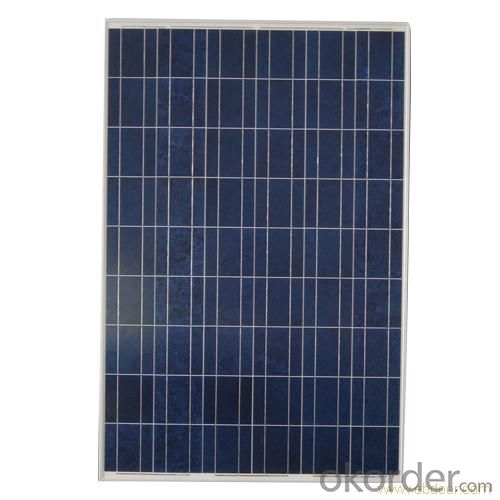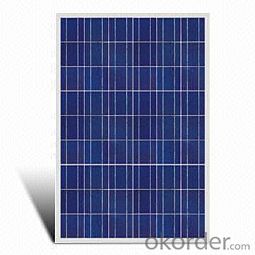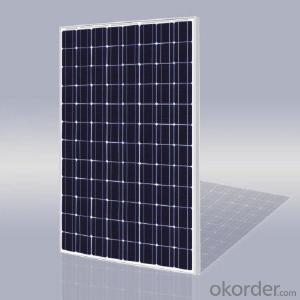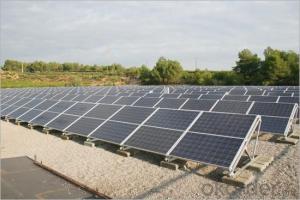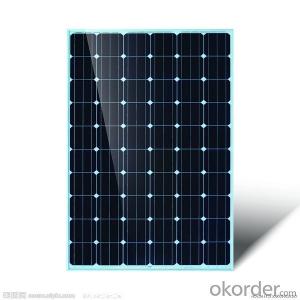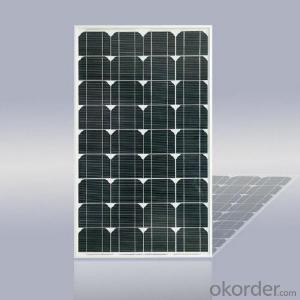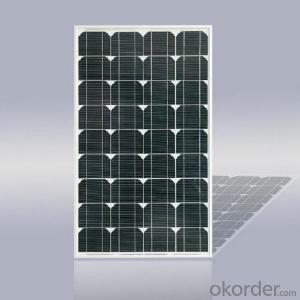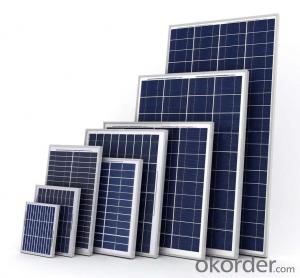High-Quality Farmland Solar Panels - 260W Solar Panel Poly for Agricultural Land
- Loading Port:
- Shanghai
- Payment Terms:
- TT OR LC
- Min Order Qty:
- 2600 watt
- Supply Capability:
- 26000 watt/month
OKorder Service Pledge
OKorder Financial Service
You Might Also Like
Specification
We now provide
• Monocrystalline Solar Panel
• Polycrystalline Solar Panel( multicrystalline silicon Solar Panel)
Features of our products:
• High conversion efficiency mono/poly-crystalline amorphous silicon solar cells
• Modules incorporate high performance bypass diodes to minimize the power drop caused by shading
• High transmittance, low-iron tempered glass
• High performance EVA encapsulant to prevent destroying and water.
• AI frame: without screw, corner connection. 8 holes on the frame can be installed easily
• Good performance of preventing from atrocious weather such as wind and hails
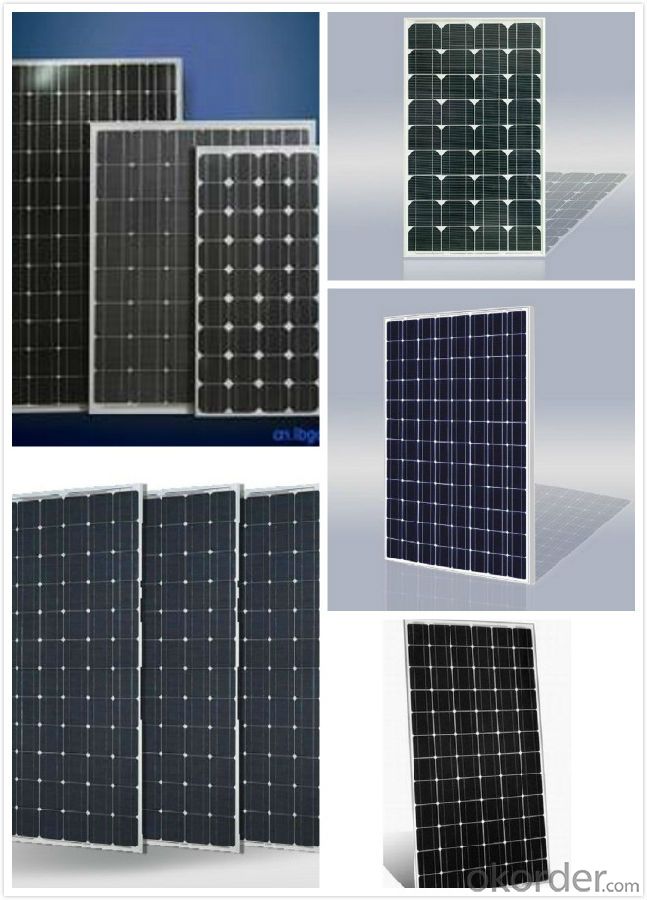
Product Description:
This installation Manual contains essential information for the electrical and mechanical installation that your must know before installing CUSTOMER PV modules. This also contains safety information you need to be familiar with .All the information described in this manual are the intellectual property of CNBM and based on the technologies and experiences that have been acquired and accumulated in the long history of CUSTOMER. This document does not constitute a warranty, expressed or implied.
CUSTOMER does not assume responsibility and expressly disclaims liability for loss, damage, or expense arising out of in anyway connected with installation, operation, use or maintenance of the PV modules. No responsibility is assumed by CUSTOMER for any infringement of patents or other rights of third parties that may result from use of PV module.
CUSTOMER reserves the right to make changes to the product, specifications or installation manual without prior notice.
Solar panel working process
In addition to being the ultimate source of all life on earth, the sun is an infinitely renewable, completely pollution-free source of electricity. Instead of burning fossil fuels dug up from the ground in a big power plant – a very 19th century, industrial age approach, when you think about it – solar panels convert sunlight directly into electricity, with no harmful emissions.
The basic unit of a solar panel is a solar cell, which usually consists of one or two layers of silicon-based semiconductor wafers. When struck by the photons in sunlight, the solar cell generates an electrical charge due to the "photovoltaic effect" – which is a pretty good name, since it produces voltage from photons. The flow of these electrons moves in a steady electrical current from one side of the cell to the other.
Dozens of these PV cells are packaged together into solar modules, which in turn are packaged into solar panels that are mounted on a rooftop and arranged to maximize their hours of exposure to direct sunlight. Because the electricity generated by all those solar cells is direct current (DC), it is then sent to an inverter that transforms the power into the same alternating current (AC) used by the appliances in your home and the local utility electricity distribution grid. Increasingly, these inverters are getting "smart," providing data monitoring for solar installation performance and other grid integration services.
FAQ
We have organized several common questions for our clients,may help you sincerely:
③Can you provide the peripheral products of the solar panels, such as the battery, controller, and inverter? If so, can you tell me how do they match each other?
Yes, we can, we have two companies for solar region, one is CNBM International, the other is CNBM engineering Co.
We can provide you not only the solar module but also the off grid solar system, we can also provide you service with on grid plant.
④What is your warranty system?
Our product performance guarantees for 25 years
• 12 years guarantee for workmanship
• Timeliness of delivery
• Quality Products certified (TÜV, UL, CE, ISO)
⑤How do you pack your products?
We have rich experience on how to pack the panels to make sure the safety on shipment when it arrives at the destination.
- Q: Can solar panels be used for powering a manufacturing facility?
- Yes, solar panels can be used to power a manufacturing facility. By harnessing the energy from the sun, solar panels can generate electricity that can be used to run various operations in a manufacturing facility, such as powering machinery, lighting, and other equipment. This can help reduce reliance on conventional electricity sources, lower operating costs, and contribute to a more sustainable and environmentally friendly business model.
- Q: My washer is 20 volts 60 gz,9.6 amps. The solar panels I am looking at are: Sharp ND-208U Solar Panels (208 Watt) List Price $,479.99 Only $,049.99 Sharp Solar Panels (208 Watt) List Price $,352.99 Only $,040.99 If I buy that will it be enough to run my washer?
- Can't answer your questions but you can find those panels for $984.50, which is signficant if you are buying more than one. An uneducated guess would be that one panel would be enough to power the clothes washer, but maybe not the clothes dryer. The washer is just a motor and a spinning device.
- Q: a) i'd like to get a solar panel to make this thing i saw in popular science, it was a bag that had a solar panel in the side (you just attach it with grommets into a clear vinyl pocket you make. its for charging elecronics and stuff) and i was wondering what kind i should look at, do they come flexible? can i get them on OKorder? what kind of wattage should i look for (btw it also had a little voltage regulator and stuff to make a little usb in your bag) so any info on that!b) i was thinking about like putting solar panels on my roof, where can i look into that, is that a good choice, has anyone done it, how did it work out? thank you, just curious
- For okorder / for information on how to hooke it up your self. It is a DIY site.
- Q: Can solar panels be used for powering a research facility or laboratory?
- Yes, solar panels can be used to power a research facility or laboratory. Solar panels convert sunlight into electricity, providing a sustainable and renewable source of power. By harnessing solar energy, research facilities and laboratories can reduce their reliance on traditional energy sources and contribute to a greener and more environmentally friendly operation. Additionally, solar panels can be integrated into the existing infrastructure of the facility, making them a viable option for powering various scientific equipment and systems.
- Q: If I put a 5000 watt solar panel kit on my roof in Dublin (Ireland) - how much electricity would I realistically expect to get?An educated guess at a percentage of 5000w would do.
- This is dependent on sun angle, clear sky, shadow interference, clouds, etc. First if you purchased the PV panels and they are rated for 5 kW, the factory rating is based on a particular incident energy, 000 watts/square meter, 25 degrees C and an AM of .5, reaching the panels. It is more likely that you will not obtain this same level in the open air. If we assume you will get 80%, then the maximum kW would be closer to 4kW. This will be produced during peak, clear days with the panels placed perpendicular to the sun at all times during peak radiance times. When the sun first comes up and later when it is going down, there will be more than the thickness of .5 atmospheres between you and the sun, so the radiant energy hitting the solar panels drops off. Total energy is watts time hours. I would expect you PV system to produce about 750 kW-Hr of energy during a clear summer day at peak solar height. Hope this helps, NewtonLaw
- Q: Is it really necessary to make solar panels that expensive?
- Unfortunately, yes. Solar panels require high-grade silicon which is very expensive. Also, volume sales aren't yet high enough to push down prices. Don't worry though, as people buy them and the technology matures it'll get cheaper. I remember DVD players costing $2000+. Now you can get one for less than $30.
- Q: Can solar panels be used in areas with high levels of bird droppings?
- Yes, solar panels can be used in areas with high levels of bird droppings. However, regular cleaning and maintenance may be required to ensure optimal performance of the panels.
- Q: I have four power packs for solar lights. They have 3 AA .2volt batteries of 2450 mAh capacity installed in series for a total supply voltage of 4 volt maximum for the lights. I want to charge all four packs at once off a single 6 volt solar panel. With the four packs wired in parallel, what capacity output (wattage) panel do I need to charge the batteries in an 8 hour day?
- 3 cells in series makes a 3.6volt 2.4AH battery. You multiply the volts but not the capacity. In parallel would be .2volts, triple capacity. So 4 packs in parallel is 9.8AH. Rule of thumb for charging a flat battery is divide capacity by 0 for amps and charge for 5 hours. amp at 6 volts is doable, that would be 6 watts People who make batteries and solar cells usually over-rate them so I doubt that a solar panel of less than 20 watts rating will fully charge these batteries if they are flat. I'd google to see how you might control the charge current with a simple circuit.
- Q: lately i have been interested in solar power. i own my own home and in Texas it's HOT, so my A/C is always on and that light bill is like $300.00 a month. i was looking at other light companies but then i remembered that there are the so called solar power but i dont knowknow to start or how it would work to power the a/c machine...pls help
- Then search the internet for the best prices on a GTS grid tie system.
- Q: what kind of degree do i need to get in order to know everythin about installing solar panels for houses?
- boots on the roof is one of the classes , around phoenix it it offered at rio salado college, there their so theres a place to start. I have had 2 different people check for me and from what i understand i can install the panels but a licensed electrition has to connect to the meter
Send your message to us
High-Quality Farmland Solar Panels - 260W Solar Panel Poly for Agricultural Land
- Loading Port:
- Shanghai
- Payment Terms:
- TT OR LC
- Min Order Qty:
- 2600 watt
- Supply Capability:
- 26000 watt/month
OKorder Service Pledge
OKorder Financial Service
Similar products
Hot products
Hot Searches
Related keywords
